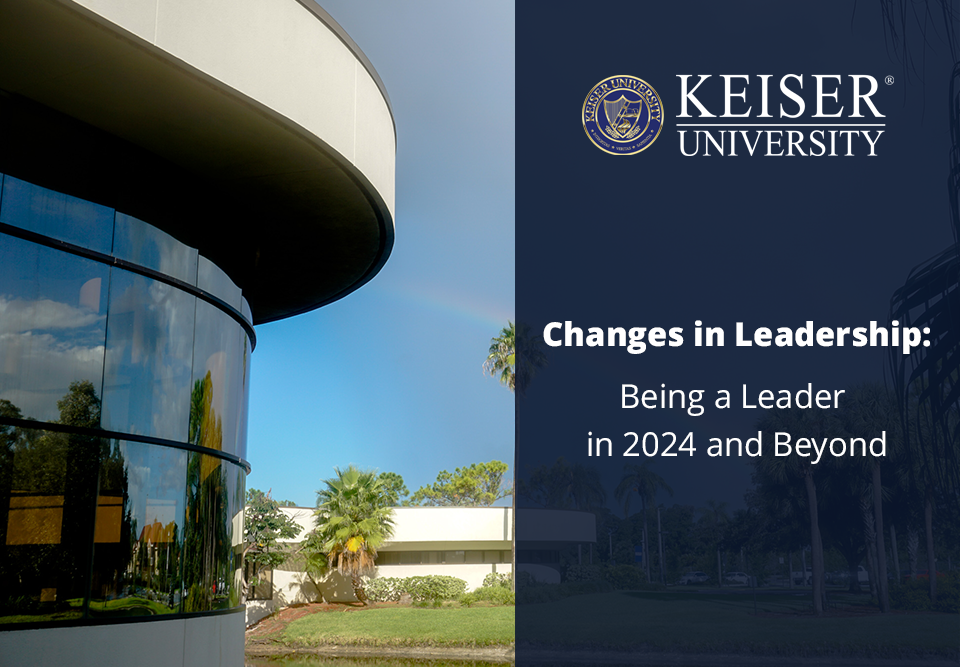The idea of leadership — and what makes a good leader — is constantly evolving. Looking toward 2024 and beyond, it’s important to be aware of the cultural shifts occurring and the new expectations being placed on leaders. Knowing how to be a future-forward, effective leader can help you achieve success, no matter your chosen industry or field.
Transformational Leadership Skills for Success with Dr. Robert Keiser | Keiser Voices Podcast

What Is Leadership?
Defined by Indeed as the process of guiding an individual or a team of professionals toward a common goal, leadership is required in every organization, regardless of its size, scope or industry. In a world that is increasingly reliant on digital technology and virtual connection, strong leadership has never been more key to an organization’s overall success.
Why Is Leadership Important?
In the corporate realm, there are various levels of leadership. In the highest tier, executive leaders focus on the big picture; they are often looking far into the future to help ensure the long-term success of their organization. Additionally, they work to shape the current corporate culture within the organization. Below the executive leadership level, you will find senior leaders, who work to enact the policies and preferences of the executives. Many organizations also have middle managers, who spend more time overseeing a team of professionals typically working on reaching actionable, short-term goals.
The leadership structure of an organization plays a pivotal role in its success, making effective leaders incredibly important. When leaders inspire and motivate those around them, the organization can fulfill its vision and reach positive outcomes for both employees and customers.
Navigating Changes as a Leader
Given their unique position at an organization, leaders are often the first to experience the tides of change. Whether you work in a middle management role or have achieved that coveted spot in the C-suite, you must be able to effectively adapt to changes in workplace expectations and cultural shifts. As the world continues to grow and evolve, leadership changes are inevitable — and you must help guide the organization through those ebbs and flows.
Recognize the Need for Change
According to the Center for Creative Leadership, recognition and understanding is the first step in navigating changes at the organizational level. By being aware of changing attitudes, processes or expectations, you can begin formulating a plan for addressing those changes. As you begin to recognize the need for change, you will want to:
- Consider the impact the change will have on the organization and its overarching mission.
- Identify and think about the scope of the change.
- Identify stakeholders who should be involved in decisions related to the change.
Set Goals and Milestones
After assembling a team of leaders who will usher in the core changes for the organization, you need to start planning for what steps to take next. Change is not always a slow and steady process, but there should still be an organized approach to this adaptation in the workplace.
Setting goals and milestones — and identifying the key figures responsible for achieving those goals — will help everyone involved feel more comfortable and confident during the transition.
H3: Identify and Address Problems
As you implement the plan you have created for the impending change, transparency is key. Individuals and teams look to their leaders to guide them through these moments of stress and uncertainty. Communicating clearly and concisely and being upfront about what changes will take place can help quell that uncertainty and improve employees’ trust.
Be mindful of the fact that there will be bumps in the road. No transition is entirely seamless, and by identifying problems and promptly addressing them, you can earn the respect of your peers and those who look to you as a leader.
Review and Adapt
As you begin settling in after the changes, it’s crucial to take a moment for self-reflection. Consider what went well during the transition, but also take note of what could have been done better. In the future, you can adapt accordingly and improve these transitions for the leadership team as well as the rest of the workforce.
Trends and Changes in Leadership
There are several distinct leadership styles that can define an individual’s leadership approach. However, the trends and changes in leadership today often require existing leaders to adapt — and incoming leaders to prepare accordingly. Knowing how to change your leadership style and accommodate the expectations of an increasingly ever-changing world could allow you to become a versatile leader who can adapt to meet the needs of those around you.
These are some of the trends shaping the nature of leadership in the modern world:
AI and Technology in Leadership
Artificial intelligence (AI) is the most revolutionary technology of our time. The advent of AI technology, along with its applications across all professional industries, is changing how leaders approach organizational structure and workplace management.
AI-informed leadership is becoming absolutely essential, according to Forbes. Leaders who are aware of the latest AI technologies and working to implement them in the workforce can help empower their employees to focus on creative tasks and provide them with the freedom to craft innovative solutions to today’s complex challenges.
AI and Leadership Development
AI also can assist with leadership development. In particular, predictive analytics can be leveraged to better understand the current landscape and make more informed decisions. By relying on predictive analytics, AI technology is capable of mining and harvesting vast amounts of data and interpreting patterns to make predictions about possible outcomes. Leaders can rely on these types of AI tools to hone their own leadership skills as well as empower their workforce to help them achieve more positive outcomes.
Technology and Leadership
The rapid changes brought on by mainstream AI technology have highlighted the critical role of technology in leadership. Modern leaders should be proactive, rather than reactive, meaning they must be able to anticipate the change process that will occur as a result of new and innovative technology.
- Leaders can best accommodate new technology by:
- Remaining aware of the latest technological trends.
- Finding ways for new technology to align with the organization’s overall vision.
- Allocating the appropriate resources to invest in new and useful technology.
- Collaborating with employees at all levels to consider a wide range of perspectives throughout the change.
- Being aware of the moral and ethical implications of new technology within the organization.
Online and Remote Team Management
The swift shift to remote work began at the onset of the COVID-19 pandemic, but now, after years of success and improved employee satisfaction ratings, this trend is here to stay for the long haul. Rather than trying to resist worker demands to stay remote, leaders should instead learn how to become effective remote team managers. Workers in every industry have found ways to make remote working, well, work — not just for themselves but also for their organizations. Typically, the leaders with a growth mindset are the ones willing to support and adapt to the preferences of employees who prefer to remain remote.
Leading Online Teams
Flexibility is key when it comes to leading online teams. One of the reasons people are so enamored with remote work is because they can find a better sense of balance, blending their personal and professional spaces in order to feel like more active participants in both areas of their lives. Leaders in charge of fully remote teams need to be aware of this and support this balance as much as possible.
Tips and Tricks
According to Forbes, these are some tips and tricks leaders can use to adapt to the leadership changes that accompany remote work environments:
- Create a schedule for check-ins. Working remotely doesn’t mean you should be disconnected from your team. One-on-one video conference calls can give you a chance to have personalized conversations with team members while also offering an opportunity to address any questions or concerns they may have.
- Communicate frequently, clearly and effectively. Communication is critical when managing a remote team, as it’s the best way to ensure everyone feels connected and understands where the team is headed.
- Set a positive example of what remote work can look like for employees. Set boundaries and maintain them, and let your team know what your boundaries are (and that they can set their own). Be transparent about your own work-life balance and encourage your team to find a similar sense of balance.
Transform Into One of Tomorrow’s Leaders at Keiser University Graduate School
Have you ever wondered, can leaders change their leadership style? At Keiser University Graduate School, we believe you have the power to transform into a thoughtful, forward-thinking leader.
We offer competency-based, insightful graduate degree programs, such as our Master of Science in Organizational Leadership and Master of Business Administration in Management, that allow students to elevate their careers to the leadership level. In addition, we offer a Management and Leadership Graduate Certificate as an expedited pathway toward senior-level leadership positions.
Our management graduate degree programs and certificates provide aspiring leaders with actionable knowledge and skills-based instruction in order to further develop the leadership skills needed in today’s global economy.
Request more information about our graduate degree programs today.






 The instructors at Keiser University impacted my life. They believed in my ability to become a great graphic designer, regardless of how I felt about my skills. KU helped to prepare me for the real world and got me to where I am today.
The instructors at Keiser University impacted my life. They believed in my ability to become a great graphic designer, regardless of how I felt about my skills. KU helped to prepare me for the real world and got me to where I am today.
